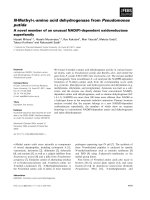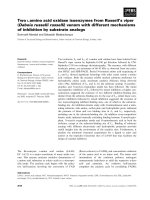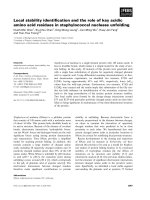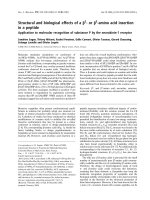Screening and evaluation of the anticancer potential of scorpion venoms and snake venom l amino acid oxidase in gastric cancer
Bạn đang xem bản rút gọn của tài liệu. Xem và tải ngay bản đầy đủ của tài liệu tại đây (7.33 MB, 226 trang )
SCREENING AND EVALUATION OF THE
ANTICANCER POTENTIAL OF SCORPION VENOMS
AND SNAKE VENOM L-AMINO ACID OXIDASE IN
GASTRIC CANCER
DING JIAN
NATIONAL UNIVERSITY OF SINGAPORE
2014
SCREENING AND EVALUATION OF THE
ANTICANCER POTENTIAL OF SCORPION VENOMS
AND SNAKE VENOM L-AMINO ACID OXIDASE IN
GASTRIC CANCER
DING JIAN
(B.S.c)
VENOM AND TOXIN RESEARCH PROGRAMME
DEPARTMENT OF ANATOMY
YONG LOO LIN SCHOOL OF MEDICINE
NATIONAL UNIVERSITY OF SINGAPORE
2014
A THESIS SUBMITTED FOR THE DEGREE OF
DOCTOR OF PHILOSOPHY
ii
ACKNOWLEDGEMENTS
I would like to take this opportunity to express my sincere gratitude to
those who give me help during my pursuit of PhD degree for the last four
years. It is obvious that this thesis could not be finished in time and with good
quality without their support.
First, I would thank my supervisor Prof Gopalakrishnakone, P, who
introduced this interesting project to me. As a supervisor, Prof Gopal helped
me design experiments, guided me to learn the knowledge and skills in
toxicology and cancer research, and more importantly encouraged me to be
confident and move forward when the project was not going smoothly. His
attitudes towards work and life also impressed me and let me know the
importance of the balance between these two factors.
Second, I would deliver my deep appreciation to my co-supervisor
Prof Bay Boon-Huat, Head of Anatomy department, NUS. Prof Bay
interviewed me and enrolled me from Zhejiang University, China, to NUS.
Furthermore, Prof Bay took me in as a member of team Anatomy and as part
of his research group. I have benefited so much from the friendly and
supportive environment in his group. Prof Bay also guided me and supported
me with detailed instructions during the whole processes of my PhD project.
He has discussed with me for most experimental problems and revised my
drafts of publications, proposals and thesis as well.
iii
Next, I would like to thank Dr Wu Ya Jun, Ms Chan Yee Gek for their
help in sample processing and viewing of TEM and SEM, respectively. I
appreciate the support on SILAC work from our collaborator Dr Jayantha
Gunaratne`s team, Quantitative Proteomics Group, Institute of Molecular &
Cell Biology, Singapore. The appreciation also goes to Ms Ng Geok Lan, Ms
Yong Eng Siang, Mr Poon Zhung Wei, Mr Gobalakrishnakone, Ms Pan Feng
and Dr Cao Qiong for their efforts in the lab management and the technique
assistance to my bench work. Similarly, the support from Ms Carolyne Ang,
Ms Diljit Kour and Ms Violet Teo for administrative issues should not be
ignored.
I am also deeply grateful for the guidance and help from my seniors,
Dr Feng Luo, Dr VGM Naidu, Dr M M Thwin, Dr Yu Ying Nan, Dr Alice Zen
Mar Lwin, Dr Chua Pei Jou and Dr Jasmine Li Jia En. I would appreciate the
partnership and friendship of my colleagues from Anatomy department, Ms
Guo Tian Tian, Ms Oliva Jane Sculy, Ms Eng Cheng Teng, Mr Denish Babu,
Mr Ashwini Kumar, Ms Cynthia Wong, Ms Shao Fei, Dr Xiang Ping, Ms Ooi
Yin Yin, Dr Parakarlane R, Mr Lum Yick Liang, and all the staff and students
in Department of Anatomy. The research wouldn`t be done in smooth and
the life wouldn`t be joyful without their company.
The last but not the least, I would especially thank my parents who
raise me up, support my education, teach me good behaviours and always
encourage, care and love me. The love from my parents and my elder sister is
the ever motivation to make progress.
iv
TABLE OF CONTENTS
DECLARATION i
ACKNOWLEDGEMENTS ii
TABLE OF CONTENTS iv
SUMMARY x
LIST OF FIGURES xiii
LIST OF TABLES xvii
ABBREVIATIONS xviii
PUBLICATIONS xxii
CHAPTER 1 1
INTRODUCTION 1
1.1 Gastric cancer 2
1.1.1 Epidemiology 2
1.1.2 Risk Factors 4
1.1.3 Classification 6
1.1.3.1 Types of gastric cancer 6
1.1.3.2 Histological classification of gastric cancer 6
1.1.4 Early screening, diagnosis and prognosis 8
1.1.5 Molecular changes in gastric cancer: genetic and epigenetic alterations 10
Microsatellite instability: 10
Involvement of p53: 11
HER-2: 12
E-cadherin: 12
1.1.6 Treatment of gastric cancer: conventional and targeted therapies 14
1.2 Scorpion venoms and toxins and their effects on cancer 18
1.2.1 Animal venoms and toxins, an introduction 18
1.2.2 Scorpion biology 20
1.2.3 Scorpion venoms and toxins 23
1.2.3.1 Sodium channel toxins (NaScTxs) from scorpion venoms 24
1.2.3.2 Potassium channel toxins (KTxs) from scorpion venoms 25
1.2.3.3 Calcium and Chloride channel toxins from scorpion venoms 26
v
1.2.3.4 Scorpion venom peptides with no disulfide bridges 27
1.2.3.5 High molecular weight enzymes 28
Hyaluronidase: 29
Phospholipase A2 (PLA
2
): 29
Proteases: 30
1.2.3.6 L-amino acid oxidases (LAAOs) from scorpion and snake venoms 31
1.2.4 The anticancer potential of scorpion venoms and toxins 32
1.3 Scope of study 37
CHAPTER 2 39
MATERIALS AND METHODS 39
2.1 Scorpion venom preparation, purification and characterization 40
2.1.1 Scorpion venom preparation 40
2.1.2 Protein concentration measurement 40
2.1.3 Sodium dodecyle sulphate-polyacrylamide gel electrophoresis (SDS-PAGE)
41
2.1.4 Size exclusive gel filtration 42
2.1.5 Cation exchange chromatography 43
2.1.6 MALDI-TOF Mass spectrometry 43
2.2 Cell culture 44
2.3 Functional studies to evaluate the anticancer effects of scorpion venom and
LAAO in vitro 46
2.3.1 Cell proliferation/viability assay 46
2.3.2 Cytotoxixity determination by Lactate Dehydrogenase (LDH) assay 46
2.3.3 Cell cycle analysis 47
2.3.4 Cell apoptosis detection by Annexin V & PI staining 48
2.3.5 Transmission electron microscopy (TEM) 49
2.3.6 Scanning electron microscopy (SEM) 49
2.3.7 Cell migration and invasion assay 50
2.3.8 Evaluation of Caspase-3 activity 51
2.3.9 Measurement of mitochondrial membrane potential 52
2.3.10 Measurement of Oxidative stress 53
2.3.11 Immunofluorescence analysis of AIF translocation 54
2.4 NUGC-3 xenograft model to assess the anticancer potential of scorpion
venom 55
vi
2.4.1 Establishment of NUGC-3 xenograft model 55
2.4.2 Intratumoral injection of venom 56
2.4.3 Tissue processing, paraffin embedding and microtome sectioning 56
2.4.4 Haematoxylin and Eosin staining 57
2.4.5 In situ apoptosis detection 58
2.5 Transcriptomic and proteomic analysis 59
2.5.1 Quantitative real-time polymerase chain reaction (qRT-PCR) 59
RNA isolation: 59
cDNA synthesis: 60
qRT-PCR: 60
2.5.2 Western blot 62
Protein extraction: 62
Western blot: 62
2.5.3 Affymetrix Gene Chip® Human Gene 2.0 ST Array 64
2.5.4 Cancer 10-Pathway Reporter Array 65
2.5.5 Stable Isotopic Labeling using Amino acids in Cell culture (SILAC) 66
2.6 Statistical analysis 67
CHAPTER 3 68
RESULTS 68
3.1 Preliminary screening of the anticancer activities of scorpion venoms 69
3.1.1 The anti-proliferative effects of Mesobuthus martensi scorpion venom 69
3.1.2 The anti-proliferative effects of crude venom from Hottentotta
hottentotta, Heterometrus longimanus and Pandinus imperator scorpions 71
3.2 Evaluating the anticancer potential of Hottentotta hottentotta scorpion
venom in gastric cancer 72
3.2.1 BHV`s inhibition to cell viability/proliferation of gastric cancer cell lines . 72
3.2.2 Evaluation of the cytotoxicity of BHV to NUGC-3 cells by LDH assay 73
3.2.3 NUGC-3 cell cycle profile after treatment with BHV 74
3.2.4 Morphological changes induced by BHV treatment in NUGC-3 cells 75
3.2.4.1 NUGC-3 morphology under fluorescence microscope 75
3.2.4.2 NUGC-3 morphology under transmission electron microscope (TEM)
77
3.2.5 NUGC-3 apoptosis detection by Annexin-V and PI staining 77
3.2.6 Detection of caspase activation after BHV treatment 79
vii
3.2.6.1 Western blot analysis of cleaved caspases 79
3.2.6.2 Caspase-3 activity assay and the influence of pan-caspase inhibitor on
NUGC-3 cell viability 81
3.2.7 BHV`s effects on NUGC-3 cell migration and invasion 82
3.2.8 The effects of BHV in NUGC-3 xenograft in vivo model 84
3.2.9 Tumor histology by Haematoxylin and Eosin staining 86
3.2.10 Apoptosis detection in tumor tissues 87
3.3 Investigation of possible mechanisms of BHV anticancer actions 88
3.3.1 Cancer 10-pathway Reporter Array 88
3.3.2 Expression of genes in MAPK/ERK pathway after BHV treatment 89
3.3.3 Regulation of phosphorylated proteins in MAPK/ERK pathway by BHV
treatment 90
3.3.4 Affymetrix gene microarray of NUGC-3 cells after BHV-F1 treatment . 92
3.3.5 Validation of apoptosis related genes by real-time PCR 98
3.4 Purification and characterization of the antitumoral agent in BHV 99
3.4.1 Characterization of crude BHV by SDS-PAGE 99
3.4.2 Size exclusive gel filtration chromatography and SDS-PAGE of fractions
100
3.4.3 Test of the inhibition effect of each fraction to NUGC-3 cell viability 101
3.4.4 Cation exchange chromatography, SDS-PAGE and cell viability test 102
3.4.5 Preliminary protein identification results with MALDI-TOF-Mass
Spectrometry 105
3.4.6 Detection of LAAO enzymatic activity in crude BHV and BHV-fractions
107
3.5 Investigating the anticancer effects of L amino acid oxidase (LAAO) in gastric
cancer 108
3.5.1 LAAO`s inhibition to cell viability/proliferation of gastric and breast
cancer cell lines 108
3.5.2 LAAO cytotoxicity to NUGC-3 cells by LDH assay 109
3.5.3 NUGC-3 cell cycle profile after treatment with LAAO 110
3.5.4 NUGC-3 cell apoptosis analysis after treatment with LAAO 111
3.5.5 Morphological changes induced by LAAO treatment in NUGC-3 cells 112
Fluorescence microscopy: 112
Scanning electron microscopy (SEM): 113
viii
Transmission electron microscopy (TEM): 114
3.5.6 Detection of caspase activation after LAAO treatment 115
3.5.7 Translocation of apoptosis inducing factor induced by LAAO 116
3.5.8 Loss of mitochondrial membrane potential of NUGC-3 cells after LAAO
treatment 118
3.5.9 Measurement of NUGC-3 oxidative stress induced by LAAO 119
3.5.10 Effects of LAAO on NUGC-3 cell migration and invasion 121
3.6 Investigation of mechanism in LAAO treated NUGC-3 gastric cancer cells
123
3.6.1 Expression of genes in MAPK/ERK pathway after LAAO treatment 123
3.6.2 Regulation of phosphorylated proteins in MAPK/ERK pathway by LAAO
treatment 124
3.6.3 Regulation of Bcl-2 family by LAAO treatment 125
3.6.4 Validation of apoptosis related genes from microarray data in LAAO
treated NUGC-3 gastric cancer cells 126
3.6.5 Proteomic regulation of NUGC-3 cells with LAAO treatment by SILAC
assay 127
3.6.6 The validation of proteins involved in MAPK/ERK pathway from SILAC
findings 132
CHAPTER 4 134
DISCUSSION 134
4.1 Anticancer potential of Hottentotta hottentotta scorpion venom and L-
amino acid oxidase 135
4.1.1 The anticancer potential of scorpion venoms, in particular BHV 136
In vitro: 137
in vivo: 142
4.1.2 The anticancer potential of LAAO from snake venom 143
4.2 Caspase-independent apoptosis, an alternative way to combat cancer 146
4.2.1 General background 146
4.2.2 Mechanistic pathway in LAAO induced CIA 147
4.3 BHV and LAAO target MAPK/ERK pathway 152
4.4 Application of cDNA microarray and SILAC to understand the biology of BHV
and LAAO-treated NUGC-3 cancer cells 158
4.4.1 Altered genes in BHV treated NUGC-3 gastric cancer cells 158
4.4.2 Altered proteins in LAAO treated NUGC-3 gastric cancer cells 161
ix
4.5 Conclusions 163
4.6 Future work 166
REFERENCES 168
APPENDICES 192
x
SUMMARY
Animal venoms and toxins from snakes, scorpions, spiders and bees,
have been widely applied in both traditional medicine and current
biopharmaceutical research. Possessing anticancer potential is another novel
discovery for animal venoms and toxins. An increasing number of studies
have shown the anticancer effects of venoms and toxins of snakes, scorpions
and others in vitro and in vivo, which were achieved mainly through the
inhibition of cancer growth, arrest of cell cycle, induction of apoptosis and
suppression of cancer metastasis. However, more evidence is needed to
support this concept and the mechanisms of anticancer actions are still not
clearly understood. Therefore, in this study, several scorpion venoms were
screened and the anticancer potential of Hottentotta hottentotta scorpion
venom (BHV) and the L-amino acid oxidase (LAAO) from Crotalus adamanteus
snake venom were extensively evaluated and investigated in NUGC-3 human
gastric cancer cells and xenograft model.
Crude venoms of Mesobuthus martensi karsch, Hottentotta
hottentotta, Heterometrus longimanus and Pandinus imperator scorpions,
were screened for their anti-proliferative effects to gastric cancer cells, with
results showing that BHV was the most inhibitory to NUGC-3 cell proliferation
with low IC50 (8.12 µg/ml). Further studies indicated that BHV decreased the
cell viability of NUGC-3 cells by cell cycle arrest at sub-G1 phase and
xi
induction of apoptosis. In NUGC-3 gastric cancer mouse xenograft model,
BHV inhibited tumor growth, histologically disrupted tumor homogeneity and
induced apoptosis in situ. Interestingly, at low concentration (2 µg/ml), BHV
also suppressed NUGC-3 cell migration and invasion.
BHV crude venom was partially purified and characterized by HPLC,
SDS-PAGE and mass spectrometry, with the identification of L-amino acid
oxidase (LAAO) as an active molecule. However, as crude BHV was almost
used up and the supplier was not able to continue the supply, a commercially
available LAAO from Crotalus adamanteus snake venom was applied to
investigate the anticancer potential of LAAO in gastric cancer cells. Similarly,
it was observed that LAAO decreased the cell viability of gastric cancer cells
dose-dependently, arrested cell cycle at G2/M phase, induced cell apoptosis
and inhibited cell migration at low concentration. These functional studies
revealed (for the first time) that BHV and LAAO from Crotalus adamanteus
snake venom exert anticancer effects in gastric cancer via cell cycle arrest,
induction of apoptosis and inhibition of cancer metastasis.
Another contribution from this work is the clarification of the
mechanisms for BHV and LAAO`s anticancer actions. A caspase-independent
apoptosis (CIA) induced by BHV and LAAO was confirmed by western blot,
caspase-3 activity assay and the presence of pan caspase inhibitor z-VAD-fmk.
Increase of intracellular ROS, with permeabilization of mitochondrial
membrane and the translocation of AIF from mitochondria to nucleus were
xii
also observed in LAAO induced CIA. Moreover, using genomic and
transcriptomic approaches, the MAPK/ERK pathway was found to be
inhibited by both BHV and LAAO treatment. Finally, several gene and protein
candidates were elucidated from microarray and SILAC data, such as EIF,
HNRNP and HSP families as well as TUBB, TOP2A and SDHA, which could be
good anticancer targets and deserve further investigations.
Taken together, this study evaluated and confirmed the anticancer
potential of BHV and LAAO from Crotalus adamanteus snake venom using
gastric cancer model. The MAPK/ERK pathway was identified as the
mechanistic pathway responsible for the anticancer activities of BHV and
LAAO. The novel findings shed light on the development of anticancer agents
from scorpion venoms and L-amino acid oxidases, and provided biological
insight into the targets for gastric cancer therapeutics.
xiii
LIST OF FIGURES
Figure 1.1 Structures of human stomach 2
Figure 1.2 Diagrammatic representations of the molecular alterations in the
progress of gastric carcinogenesis 13
Figure 1.3 A diagrammatic representation of novel target-based drugs in gastric
cancer treatment 16
Figure 1.4 Representative geographic distribution of Buthida scorpions around the
world 21
Figure 1.5 Anatomy of scorpion represented by the Heterometrus spinifer
scorpion 22
Figure 1.6 Representative diagram of scorpion venom glands 23
Figure 2.1 Flow chart of Affymetrix DNA microarray 65
Figure 2.2 Plate components for Cancer 10-Pathway Reporter Array 66
Figure 3.1 AlamarBlue cell viability/proliferation assay of cancer cells after BmK
venom treatment 69
Figure 3.2 Representative profiles of NUGC-3 cell cycle and cell apoptosis analysis
by flow cytometry 70
Figure 3.3 AlamarBlue cell viability/proliferation assay of NUGC-3 cells after
treatment with PIV, HLV and BHV 72
Figure 3.4 AlamarBlue cell viability/proliferation assay of gastric cancer cells after
treatment with BHV 73
Figure 3.5 BHV cytotoxicity to NUGC-3 cells by LDH assay 74
Figure 3.6 BHV treatment induced the changes of NUGC-3 cell cycle
profile 75
Figure 3.7 NUGC-3 morphological changes after BHV treatment by AO-EB
staining 76
Figure 3.8 Morphological changes seen in NUGC-3 cells after BHV treatment under
TEM 77
Figure 3.9 Flow cytometric analysis of NUGC-3 cell apoptosis with Annexin V and PI
staining 78
xiv
Figure 3.10 Western blot of caspase proteins in NUGC-3 cells after treatment with
BHV 80
Figure 3.11 Confirmation of caspase independent apoptosis induced by BHV
treatment 81
Figure 3.12 NUGC-3 gastric cancer cell migration assay after treatment with
BHV 82
Figure 3.13 NUGC-3 gastric cancer cell invasion assay after treatment with
BHV 83
Figure 3.14 Tumor growth rate of NUGC-3 xenograft after BHV treatment 85
Figure 3.15 Tumor histology with H & E staining 86
Figure 3.16 Apoptosis in situ analysis in tumor sections after BHV
treatment 87
Figure 3.17 Activity of pathways in NUGC-3 cells after BHV treatment by Cancer
10-Pathway Reporter Array 88
Figure 3.18 Expression of genes in MAPK/ERK pathway by reat-time……………… …89
Figure 3.19 Regulation of MAPK/ERK pathway in NUGC-3 cells by BHV analyzed by
western blot 91
Figure 3.20 Hierarchical clustering of differentially expressed genes from
microarray 93
Figure 3.21 Volcano plot of microarray data 94
Figure 3.22 Validation of apoptosis related genes from microarray data by real-
time PCR 98
Figure 3.23 10% SDS-PAGE pattern of crude BHV in two different separation
conditions 99
Figure 3.24 Superdex G75 gel filtration chromatography of crude BHV 100
Figure 3.25 10% SDS-PAGE profile of gel filtration fractions 101
Figure 3.26 NUGC-3 cell viability assay after treatment with gel filtration
fractions 102
Figure 3.27 UNO S1 cation exchange chromatogram of BHV-F1 103
Figure 3.28 10% SDS-PAGE profile of fractions after BHV-F1 separation 104
Figure 3.29 NUGC-3 cell viability assay after treatment with fractions after cation
exchange chromatography 104
xv
Figure 3.30 Indication of the bands that were cut from PAGE gel for mass spectrum
analysis 105
Figure 3.31 Mass spectrum of F1-C-b band 106
Figure 3.32 Probability Based Mowse Score and protein summary report 106
Figure 3.33 LAAO enzymatic activity assay in BHV fractions……………………………….107
Figure 3.34 AlamarBlue cell viability/proliferation assay of gastric and breast cancer
cells after treatment with LAAO 108
Figure 3.35 LAAO cytotoxicity to NUGC-3 cells by LDH assay 109
Figure 3.36 LAAO treatment induced the changes of NUGC-3 cell cycle
profile 110
Figure 3.37 Flow cytometry analysis of NUGC-3 cell apoptosis with LAAO
treatment 111
Figure 3.38 NUGC-3 morphological changes after LAAO treatment by AO-EB
staining 112
Figure 3.39 NUGC-3 morphological changes after LAAO treatment under SEM 113
Figure 3.40 NUGC-3 morphological changes after LAAO treatment under TEM 114
Figure 3.41 Confirmation of caspase independent apoptosis induced by LAAO
treatment 115
Figure 3.42 Immunofluorescence staining of NUGC-3 cells after LAAO
treatment 117
Figure 3.43 Flow cytometry analysis of NUGC-3 cells with JC-1 staining 118
Figure 3.44 Flow cytometry analysis of NUGC-3 cells stained with DCF-DA 119
Figure 3.45 Whole cell lysate western blot against MDA 120
Figure 3.46 NUGC-3 gastric cancer cell migration and invasion assays after
treatment with LAAO 122
Figure 3.47 Expression of genes in MAPK/ERK pathway by reat-time PCR 123
Figure 3.48 Regulation of MAPK/ERK pathway in NUGC-3 cells by LAAO analyzed by
western blot 124
Figure 3.49 Regulation of Bcl-2 family in NUGC-3 cells by LAAO analyzed by western
blot 125
Figure 3.50 Validation of apoptosis related genes in LAAO treated NUGC-3 cells by
real-time PCR 126
xvi
Figure 3.51 Validation of proteins involved in MAPK/ERK pathway by real-time PCR
and western blot………………………………………………………………………………………………… 133
Figure 4.1 Networks of cell cycle related genes analyzed by Pathway Studio……159
Figure 4.2 Networks of cell apoptosis related genes analyzed by Pathway
Studio……………………………………………………………………………………………………… 160
Figure 4.3 Diagram showing the possible mechanistic pathways of how LAAO/BHV
exerts the anticancer effects to NUGC-3 cells 165
Supp. Figure 1 Image of Hottentotta hottentotta scorpion 192
Supp. Figure 2 Identification of voltage-gated potassium channels in NUGC-3 cells
by path clamp 192
Supp. Figure 3 Gene expression of voltage gated ion channels in NUGC-3 cells 193
Supp. Figure 4 Measurement of mouse serum alanine transaminase (ALT)
activity 193
Supp. Figure 5 Role of catalase in LAAO induced reduction of cell viability of NUGC-3
cells 194
xvii
LIST OF TABLES
Table 1.1 Gastric cancer classification systems 7
Table 1.2 FDA approved drugs derived from animal venoms 19
Table 1.3 Important molecules purified from scorpion venoms with
anticancer potential 36
Table 2.1 Recipe of resolving gel and stocking gel 42
Table 2.2 Cell lines, cell maintenances and subculture conditions 45
Table 2.3 Program settings for tissue processing 57
Table 2.4 Sequences of primers used in real-time PCR 61
Table 2.5 Antibodies used in western blot 63
Table 3.1 List of differentially expressed genes in NUGC-3 cells after BHV-F1
treatment by Affymetrix microarray 95
Table 3.2 Functional classification of differentially expressed genes from
Affymetrix microarray 97
Table 3.3 List of differentially expressed proteins in NUGC-3 cells after LAAO
treatment by SILAC assay 127
Table 3.4 Functional classification of differentially expressed proteins from
SILAC assay 131
Supp. Table 1 Record of body weight of mice after BHV injection 194
xviii
ABBREVIATIONS
5-FU
5-Fluorouracil
AGAP
Analgesic-antitumor peptide
AIF
Apoptosis inducing factor
ANOVA
Analysis of variance
AO/EB
Acridine orange / ethidium bromide
APS
Ammonium persulfate
ARS
Age standardized rate
BHV
Buthus hottentotta (Hottentotta hottentotta) venom
BmK
Buthus martensii (Mesobuthus martensii) karsch
BSA
Bovine serum albumin
caspase
Cysteine-containing aspartate-directed protease
CCCP
Carbonyl cyanide 3-chlorophenylhydrazone
CIA
Caspase independent apoptosis
CTX
Chlorotoxin
DAPI
4,6-diamidino-2-phenylindole
DAVID
Database for Annotation, Visualization and Integrated
Discovery
DCF
2’,7’ - dichlorofluorescin
DCFDA
2’,7’ - dichlorofluorescein diacetate
DEPC
Diethyl pyrocarbonate
DMSO
Dimethylsulfoxide
xix
Dox
Doxorubicin
DTT
Dithiothreitol
EDTA
Ethylenediaminetetraacetic acid
EGFR
Epidermal growth factor recepotr
EIF
Eukaryotic translation initiation factor
ERK
extracellular signal-regulated kinase
FBS
Fetal bovine serum
FDA
Food and drug administration
H. pylori
Helicobacter pylori
HER-2
Human epithelial growth factor 2
HNRNP
Heterogeneous nuclear ribonucleoprotein
HPLC
High performance liquid chromatography
HSP
Heat shock protein
JC-1
5,5',6,6'-tetrachloro-1,1',3,3'- tetraethyl-imidacarbocyanine
iodide
JNK
c-Jun NH2-terminal kinase
kDa
Kilo dalton
KTxs
Potassium channel toxins
LAAO
L-amino acid oxidase
LDH
Lactate dehydrogenase
M.W.
Molecular weight
MALDI-TOF-MS
Matrix-assisted laser desorption/ionization time of flight mass
spectrometry
xx
MAPK
Mitogen-activated protein kinase
MDA
Malondialdehyde
MEK
MAPK kinase
MMP
Mitochondrial membrane potential
MMp
Mitochondrial membrane permeabilization
MMPs
Matrix metalloproteinases
MSI
Microsatellite instability
MSK
Mitogen- and stress-activated protein kinase
NaScTxs
Scorpion Na
+
channel toxins
NDBPs
Non disulfide-bridged peptides
OD
Optical density
p90RSK
90 kDa ribosomal S6 kinase
PARP
Poly (ADP-ribose) polymerase
PBS
Phosphate buffered saline
PI
Propidium iodide
PLA
2
Phospholipase A2
PS
Phospholipid phosphatidylserine
PTEN
Phosphatase and tensin homolog
PVDF
Polyvinyl difluoride
ROS
Reactive oxygen species
RT
Room temperature
RT-PCR
Real-time polymerase chain reaction
SDS-PAGE
Sodium dodecyle sulphate-polyacrylamide gel electrophoresis
xxi
SEM
Scanning electron microscopy
SEM
Standard error of the mean
SILAC
Stable Isotopic Labeling using Amino acids in Cell culture
TBS
Tris buffered saline
TBST
Tris buffered saline in 1% tween-20
TEM
Transmission electron microscopy
TEMED
N,N,N’,N’- tetramethylethylenediamine
TOP2A
Topoisomerase (DNA) II alpha
TUBB
Tubulin
TUNEL
Deoxynucleotidyl transferase (TdT) dUTP nick end labeling
VEGF
Vascular endothelial growth factor
xxii
PUBLICATIONS
Book Chapter
Jian Ding, Boon-Huat Bay, P Gopalakrishnakone. Animal venoms and toxins, a
novel approach in breast cancer treatment. Advances In Breast Cancer Biology
And Clinical Management. G. Yip and B.H. Bay, 2012
Journals
Jian Ding, Pei-Jou Chua, Boon-Huat Bay, P Gopalakrishnakone. Scorpion venoms
as a potential source of novel cancer therapeutic compounds. Exp Biol Med 2014,
4, 378-393 (IF=2.226).
Patent pending
Title: L-Amino Acid Oxidase (LAAO) From Crotalas Adamanteus Venom Induces
Caspase-Independent Apoptosis in Human Gastric Cancer Cells.
Inventors: Jian Ding, P Gopalakrishnakone (PI), Boon-Huat Bay, Pei-Jou Chua.
Status: patent filing by US Provisional Application No.: 61/976,567.
Conference Proceedings
Jian Ding, Boon-Huat Bay, P Gopalakrishnakone. Scorpion venom induces
cytotoxicity in human gastric cancer cells in vitro. The 2nd International
Anatomical Sciences and Cell Biology Conference. Chiang Mai, Thailand,
Dec.2012
Jian Ding, Pei-Jou Chua, Boon-Huat Bay, P Gopalakrishnakone. Screening the
anti-cancer potential of scorpion venom in gastric cancer in vitro and in vivo. XI
Congress of Pan-American Society of the International Society on Toxicology.
Brazil, Nov. 2013
xxiii
Jian Ding, Boon-Huat Bay, P Gopalakrishnakone. Transcriptomic Studies of
Gastric Cancer Cells with Scorpion Venom Treatment. Yong Loo Lin School of
Medicine 4th Annual Graduate Scientific Congress. Singapore, Mar. 2014
Jian Ding, Boon-Huat Bay, P Gopalakrishnakone. L-amino acid oxidase from
Crotalus adamanteus venom induces caspase-independent apoptosis in human
NUGC-3 gastric cancer cells. American Association for Cancer Research (AACR)
Annual Meeting 2014. USA, Apr. 2014
Other publication by the candidate
VGM. Naidu, Bandari Uma Mahesh, Ashwini Kumar Giddam, Kuppan Rajendran
Dinesh Babu, Jian Ding, K Suresh babu, B Ramesh, Rajeswara Rao Pragada,
Gopalakrishnakone P. Apoptogenic activity of ethyl acetate extract of leaves of
Memecylon edule on human gastric carcinoma cells via mitochondrial
dependent pathway. Asian Pac J Trop Med 2013, 412-420 (IF=0.926).









